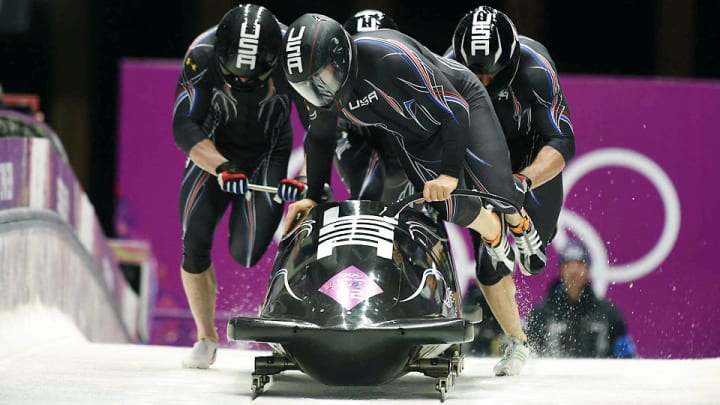U.S.' Holcomb navigates on-, off-track obstacles for 2nd bobsled medal

SOCHI -- It would be easy to cast Steve Holcomb, gold-medal pilot of the top U.S. four-man bobsled in Vancouver, as a disappointment after he only won bronze Sunday afternoon in the same event, the Americans’ final medal opportunity in Sochi. But that would discount the obstacles thrown at Holcomb and his sled, USA-1, a.k.a. Night Train II.
Holcomb simply sat in the sled or ran alongside it during four of six official four-man training runs, rather than push and risk aggravating a calf muscle he had strained during the two-man competition. That meant the choreography of USA-1’s “load,” those critical five seconds at the start when a team must push and efficiently clamber into the sled, was rusty for Saturday’s first half of the competition, which ended with the U.S. sitting out of the medals in fourth.
Meanwhile Holcomb’s Russian counterpart, Alexander Zubkov, had been leveraging a huge home-track advantage all Olympics long. Indeed, Russia-1 went on to win the four-man gold, with Latvia taking the silver.
But for his part, Holcomb was hardly disappointed with his second medal of these Olympics, to add to the bronze he had won in the two-man.
WOLFF: Once nearly blind, suicidal, Holcomb drives U.S. to historic two-man bobsled medal
“In less than a week’s time, I’ve gone from being an Olympic medalist to being a three-time Olympic medalist,” he said.
Nor should Holcomb be disappointed. He and Steve Langton, who did pusher duty on the top U.S. sleds in both the two-man and four-man, are the only Americans, aside from ice dancers Meryl Davis and Charlie White, to win more than one medal in Sochi.
And the seven medals won by the U.S. at the Sanki Sliding Center -- one in luge (Erin Hamlin), two in skeleton (Noelle Pikus-Pace and Matt Antoine) and two in women’s bobsled (Elana Meyers and Lauryn Williams and Jamie Greubel and Aja Evans) to go with the two that Holcomb delivered -- made for the best Olympic showing ever by American sliders on foreign soil.
All week, U.S. drivers had talked about their love-hate relationship with the Sanki track. With its 17 turns, including three uphill stretches designed to suppress speeds after the death of Georgian luger Nodar Kumaritashvili in Vancouver, it was the kind of course a technical driver like Holcomb would ordinarily love. But it also seemed like a puzzle with an ever-changing solution.
“You can have a great run and a slow time,” Holcomb said, “and a bad run and a super-fast time.”
Moreover, if you made a mistake, especially early in the course, you could stall out on the uphills. “Unfortunately, you can’t gain time,” Holcomb said. “It’s all about who loses the least.”
With USA-1 nursing a .15 second lead over Russia-2 going into its final run, Holcomb made a mistake in Curve Five and had his trouble compounded over the rest of the course. On a gloriously sunny final day of the Olympics, just hours before the closing ceremony, split times showed how USA-1’s lead over Russia-2, which had taken its turn just before, was melting away: from .25 seconds, to .16, to .09, to .04 . . .
“When you come over Curve 15, you can see the clock, and it was still green up there,” Holcomb said, referring to the color that indicates when a sled on the track is ahead of the best time posted to that point. “I thought, ‘Just keep it up.’”
Meanwhile USA-2 pusher Johnny Quinn, who from his door-breaking exploits earlier in these games we know to be no introvert, was near the finish, vocalizing the same sentiment. “C’mon, boys, c’mon!” he yelled. “Find the speed!”
USA-2 crossed the line three-hundredths of a second ahead of Russia-2 to clinch its spot on the podium.
Holcomb, who will turn 34 in April, all but pledged to be in a cockpit in Pyeongchang four years from now. “I love what I do and don’t want to get a real job,” he said. “I look at Zubkov -- he’s 39 and he’s winning. [2018] looks promising to me.”
With the top South Korean sled here finishing 20th, a home-track advantage doesn’t figure to vault a local driver onto the podium in Peyongchang the way Sanki was so friendly to Zubkov. Or so someone suggested to Holcomb.
He shot the premise down with the kind of attention to detail that helps make for a great driver: “Don’t count the Koreans out. They’ve come a long way the last four years. Their push is as good as ever.”
He sounded like a man still up for Olympic challenges, whether they come in the guise of a course or a competitor.
